U.S.S. Enterprise Cargo & Transport
Created by Commodore Wilkan Targaryen on Wed Jul 24th, 2024 @ 12:22am
Cargo
Cargo Bays (Primary)
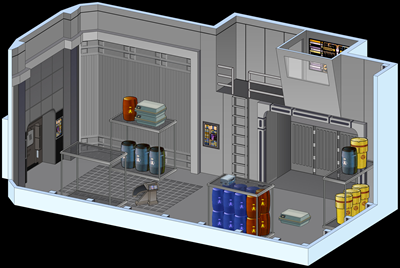 The Cargo Bay, or Cargo Hold as it was sometimes referred to, was a general-purpose storage facility aboard the Enterprise.
The Cargo Bay, or Cargo Hold as it was sometimes referred to, was a general-purpose storage facility aboard the Enterprise.Clustered around the Docking Bay in the Primary Hull, Cargo Bays were either assigned to hold goods to be delivered to another location or for storing supplies for the ship's crew (also known as ship's stores). Cargo Bays in the Primary Hull were smaller than their counterparts in the Secondary Hull but featured similar equipment and technologies as one another. Surprisingly, few of these Cargo Bays were equipped with Cargo Transporters to assist in the moving of cargo containers; however, cargo could be transported into the bay by a Transporter Specialist operating in a Transporter Room or from one of the Cargo Bays equipped with a Cargo Transporter. Often, these Cargo Bays opened into the Docking Bay to allow for the quick transfer of cargo from vessels to the Enterprise, but some bays did include doors leading to the exterior of the vessel. Shuttlecraft and Workbees loaded with cargo management units could be flown into directly into these bays depending upon the situation.
Cargo Bays (Secondary)
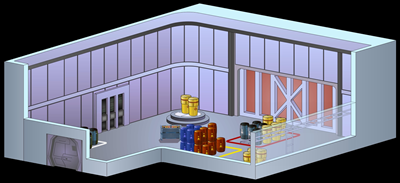 The Cargo Bay, or Cargo Hold as it was sometimes referred to, was a general-purpose storage facility aboard the Enterprise.
The Cargo Bay, or Cargo Hold as it was sometimes referred to, was a general-purpose storage facility aboard the Enterprise.Located on the lower decks of the Stardrive Section, Cargo Bays were either assigned to hold goods to be delivered to another location or for storing supplies for the ship's crew (also known as ship's stores). Larger than their counterparts in the Saucer Module, the Cargo Bays in the Engineering Hull were multi-level facilities shared similar equipment to the other bays yet were often better appointed. Almost every Cargo Bay was equipped with a Cargo Transporter to assist in the moving of cargo containers into the region and most of the bays featured doors that opened into space, allowing for the quick transfer of cargo and other goods. Anti-gravity units and Tractor Beam Generators were fitted to assist in moving large containers with ease while a cargo conveyor connected the forwardmost cargo bays to those aft.
Due to their size, Cargo Bays in the Engineering Hull were frequently used in a variety of ways other than typical storage, including as triage centers, brigs, and stasis unit facilities depending on mission need.
Storage Compartment
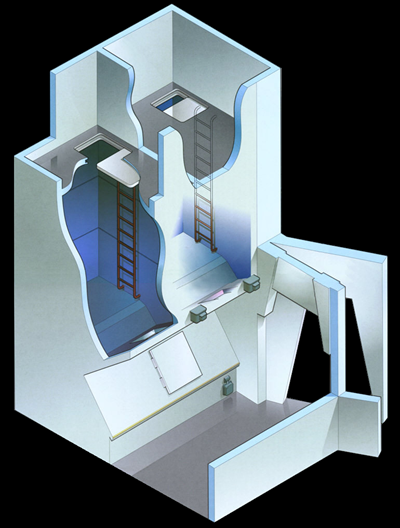 Storage Compartments were a specialized facility in which various items were kept. Aboard the Starship Enterprise, Storage Compartments were often used to store materials that were unable to be replicated or were not easily obtained. Among the most common items stored aboard the Enterprise in Storage Compartments were deuterium and fresh water; however, other materials could also be maintained aside from liquids. Depending upon the nature of the items stored, Starfleet Security personnel could be assigned to continually guard the location to protect their cargo.
Storage Compartments were a specialized facility in which various items were kept. Aboard the Starship Enterprise, Storage Compartments were often used to store materials that were unable to be replicated or were not easily obtained. Among the most common items stored aboard the Enterprise in Storage Compartments were deuterium and fresh water; however, other materials could also be maintained aside from liquids. Depending upon the nature of the items stored, Starfleet Security personnel could be assigned to continually guard the location to protect their cargo.The typical Storage Compartment aboard the Enterprise featured a base layout with access provided either by an entry hatch at the top of the unit or from the bottom via corridor-based access. Each Storage Compartment is large enough to store a variety of goods by design, but often the storage areas are divided into sections by archways constructed along their outer passages. Each compartment has a fixed ladder that runs the entire height of one of the tankage walls, which allows the room to be easily maintained when empty, and ease of movement through these high security areas.
While most Storage Compartments are fixed locations aboard the Century Class, some compartments have been designed to be detached from the outer hull and extracted. This allows for the quick transfer of goods from the vessel to another location, such as a starbase, planet, or another vessel.
Transport
Airlock
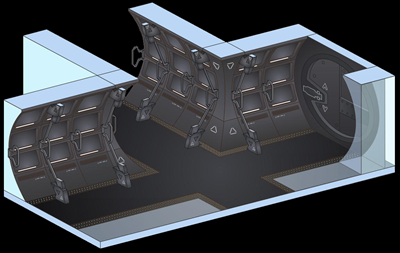 Airlocks aboard the Starship Enterprise were points of entry to the starship which allowed ingress and egress to empty space or another vessel or station which had docked with the portal. Century Class starship airlocks were located on the port and starboard sides of the vessel but were concealed by hull plating that extended out to reveal the airlock doors when needed. The only unobstructed airlocks were located adjacent to the Forward Torpedo Launchers on the port and starboard sides of Deck 19.
Airlocks aboard the Starship Enterprise were points of entry to the starship which allowed ingress and egress to empty space or another vessel or station which had docked with the portal. Century Class starship airlocks were located on the port and starboard sides of the vessel but were concealed by hull plating that extended out to reveal the airlock doors when needed. The only unobstructed airlocks were located adjacent to the Forward Torpedo Launchers on the port and starboard sides of Deck 19.Airlocks aboard the Enterprise were similar in design to the corridors of the starship, but featured thick security gates used to isolate the interior of the vessel from space. The exterior airlock featured a universal fitting designed to be compatible with all known airlocks currently encountered by the Federation. The airlock could further deploy a set of long, foldable bridges that could fold out and dock with another spacecraft to extend the airlock's reach. These bridges were then sealed with force fields, allowing for rapid transfer of crew. The airlock corridors were normally dark, but extensive lighting would be activated when Enterprise was docked with a craft to enhance the safety of users of the airlock during transit. Sophisticated security sensors incorporated built-in weapon detectors that were capable of detecting military technology carried by persons boarding the Enterprise from docked starships or bases. A nearby cabinet stored environmental suits, a special form of clothing designed to be used for protection or life support in inhospitable environments, and other equipment that may be needed.
Corridor
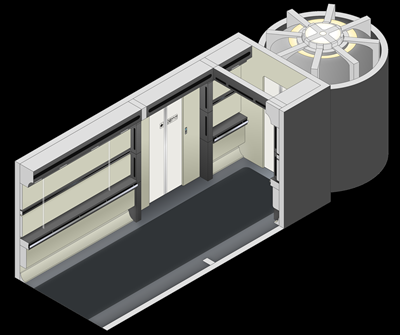 A Corridor is a pathway located within the Starship Enterprise that connected various stations or quarters, and as lengthy hallways through which one accessed various rooms aboard the ship.
A Corridor is a pathway located within the Starship Enterprise that connected various stations or quarters, and as lengthy hallways through which one accessed various rooms aboard the ship. Corridors on board Starfleet vessels were usually of two types: radial (those which ran outward, pointing toward the outer hull) and concentric (those which lay in rings, interconnecting the radial corridors). The angled surfaces of each concealed different support structures to aid the crew in their missions. Radial corridors were angled on either side and their walls concealed a variety of supply lines and conduction systems, data networks, and power trunks. These systems were accessible by the removal of the snap-locked panels which cover them, and all were marked. The ship's concentric corridors housed personnel support systems.
Several safety and survival features were built into the walls and ceilings of Corridors, as were running lights to indicate whenever the starship was operating under alert status. In each corridor segment, an emergency survival compartment existed which provides atmosphere, food and communications for one crew member; this provision was to be used should sudden decompression of the ship interior occur due to hull damage or life support failure. For safety purposes force fields could be erected in corridors to confine intruders or isolate a section of the ship from others.
Docking Bay
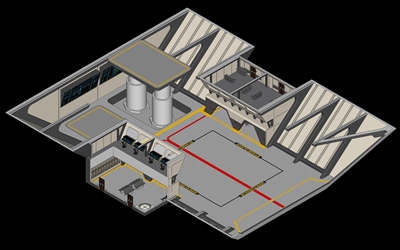 Located at the base of the Saucer Module, the Docking Bay aboard the U.S.S. Enterprise is the largest single location aboard the entire craft. Comprised of five levels in the very core of the Primary Hull, the Docking Bay is a remnant of the initial plans for the Century to be a mobile outpost and carrier starship.
Located at the base of the Saucer Module, the Docking Bay aboard the U.S.S. Enterprise is the largest single location aboard the entire craft. Comprised of five levels in the very core of the Primary Hull, the Docking Bay is a remnant of the initial plans for the Century to be a mobile outpost and carrier starship.The Docking Bay aboard the Enterprise was entered via airlock pressure doors located on Deck 15. Vessels wishing to dock with the Enterprise would enter through a large door built into the floor plating of Deck 15 and would ascend into the bay. For larger vessels a docking pylon descended from the ceiling into the room allowing for a vessel to connect with the Enterprise and transfer cargo or crew aboard the vessel, while smaller craft could use one one of the elevators to be raised into the maintenance area. The Enterprise Spaceflight Terminal, decorated with a gold pressed model of the Enterprise, was located nearby for new arrivals and departures to become acquainted with the vessel. Large displays provided information about arrivals and departures. A number of Cargo Bays, Guest Quarters, and workshops were located around the edge of the Docking Bay to support the vessels docked inside.
While the Docking Bay aboard the Enterprise is commonly used by others, the area also maintains equipment, supplies, and vehicles to support the Enterprise in her missions. The Enterprise's Mission Support vessel, the U.S.S. Galileo Galilei, utilizes the Docking Bay when not on its own assignments as well as the Enterprise's Captain's Yacht.
Hangar Bay
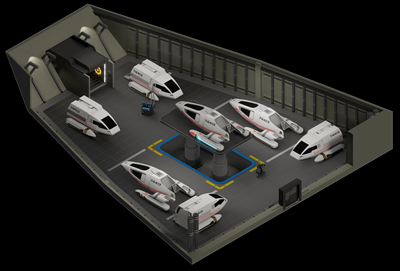 Located near to each Shuttlebay aboard the Starship Enterprise, the Hangar Bay was a specialized facility used for storing shuttlecraft and related vehicles in a safe and secure area.
Located near to each Shuttlebay aboard the Starship Enterprise, the Hangar Bay was a specialized facility used for storing shuttlecraft and related vehicles in a safe and secure area. Utilized for the construction, repair, and storage of auxiliary craft, each Hangar Bay had a similar function aboard the Enterprise but not a uniform design based upon their location aboard the vessel. Each Hangar Bay was a large room that contained designated parking areas for each support craft assigned to it. Maintenance equipment could be deployed to each parking area to perform diagnostic maintenance of the shuttles as needed, but more complicated repairs could be moved to a Shuttle Maintenance Bay. Connective hoses would be used to transfer fuel from nearby tanks to the support craft during fueling. When a shuttle was needed for a mission, specialized tractor beams would move the shuttle from its parking area to the centralized elevator to move the craft to the Shuttlebay.
Each Hangar was equipped with a vehicle replicator. A specialized industrial replicator, the vehicle replicator was a large-scale replicator that was able to quickly create mechanical parts or any means of transportation, including shuttlecraft, if needed. The vehicle replicator worked by stringing together individual replicated components at a time, providing audio updates as construction proceeded until completion.
Shuttlebay 1 and 2
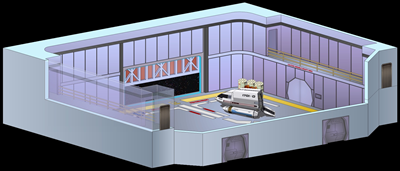 Located in the aft section of the Enterprise's Saucer Module, Shuttlebay 1 and 2 was situated between the primary hull's Impulse Engines and was externally accessed via two large roll-up hangar doors (which could be operated independently for small craft or cooperatively for larger vehicles) and internally through pressure doors on Deck 08. Due to the Enterprise's mission objectives Shuttlebay 1 and 2 extended further than typical for a vessel its size, directly connecting to the large Hangars located in the Saucer Module. Nearby Shuttle Maintenance Bays are accessed through doors built into the aft bulkhead.
Located in the aft section of the Enterprise's Saucer Module, Shuttlebay 1 and 2 was situated between the primary hull's Impulse Engines and was externally accessed via two large roll-up hangar doors (which could be operated independently for small craft or cooperatively for larger vehicles) and internally through pressure doors on Deck 08. Due to the Enterprise's mission objectives Shuttlebay 1 and 2 extended further than typical for a vessel its size, directly connecting to the large Hangars located in the Saucer Module. Nearby Shuttle Maintenance Bays are accessed through doors built into the aft bulkhead.Shuttlebay 1 and was a colossal chamber aboard the Enterprise and spanned three decks. Large enough to house as many as three runabouts each, twin catwalks ran along the walls of the Shuttlebay to provide for the visual inspection of any support craft docked within the Enterprise. A large control room was built within the catwalk structure to allow for the control of all shuttlecraft operations originating from Shuttlebay 1 and 2. During normal operations specialized forcefield technology was used to prevent the decompression of the Shuttlebay while the exterior door was open, but advanced safety systems were available to protect personnel in the event that the containment field failed.
Brightly lit, Shuttlebay 1 and 2 was designed to maximize functional space and to keep deck space uncluttered. Temporary storage space was available to store cargo and other supplies close to the Shuttlebay for loading and unloading. Landing lights and floor markings aided pilots in navigating craft into the Shuttlebay to help avoid incident. Under normal operations, however, a combination of computer assisted guidance and tractor beams were used to safely position a craft aboard the Enterprise. Due to the risk of hazards impacting the Enterprise's mission, a shuttle could successfully be launched or land aboard the vessel in less than ten seconds in an emergency.
Shuttlebay 3
 Shuttlebay 3 is one of three Shuttlebay facilities aboard the Century Class Starship Enterprise. Comprised of multiple levels accessible from Deck 15, Shuttlebay 3 was enormous and had several design and systems upgrades to make operations safer for all personnel and guests to the vessel.
Shuttlebay 3 is one of three Shuttlebay facilities aboard the Century Class Starship Enterprise. Comprised of multiple levels accessible from Deck 15, Shuttlebay 3 was enormous and had several design and systems upgrades to make operations safer for all personnel and guests to the vessel.Brightly lit to enhance the safety of its operations, Shuttlebay 3 was externally accessed by a large pair of clamshell doors which parted in the middle and retracted into the sides of the vessel's hull to allow support vessels to enter and exit the spacecraft. Specialized forcefield technology prevented decompression of the Shuttlebay when the space doors were opened but allowed shuttlecraft or other vehicles egress. In an emergency the forcefield could be deactivated to cause an emergency decompression strong enough to move the Enterprise herself.
Support vessels ready for deployment were transferred into Shuttlebay 3 via a large vehicle elevator positioned in the center of the room; however, vehicles could also be parked along the side bulkheads of the Shuttlebay if needed. Above the far wall of the Main Shuttlebay was an Observation Room that was used by personnel to oversee shuttlecraft operations. Temporary storage space was located on each side of the Shuttlebay to allow the bay floor to remain unobstructed, while access to the corridor was provided by a single door located directly beneath the Observation Room. Entry to enhanced Shuttlecraft Maintenance Bays were available on both sides of the exit into the Enterprise. Landing lights were prominently positioned to provide guidance during landings, and written warnings were displayed across the bay floor to assist pilots on manual approach. Despite this, most landings were automated using a combination of computer assisted guidance and tractor beam. Should a shuttle escape all other protections, emergency nets were concealed within the floor that could be deployed to try to minimize damage if the shuttle had been disabled.
Shuttlecraft Maintenance Bay
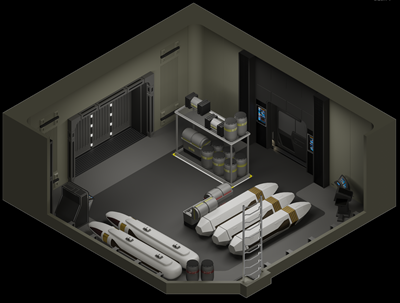 Shuttlecraft Maintenance Bays are specialized chambers constructed adjacent to the Hangar Bays and Shuttlebays of the Starship Enterprise that are used for the repair of small craft. Staffed by trained Engineers, access to each Shuttlecraft Maintenance Bay is restricted due to the equipment stored there.
Shuttlecraft Maintenance Bays are specialized chambers constructed adjacent to the Hangar Bays and Shuttlebays of the Starship Enterprise that are used for the repair of small craft. Staffed by trained Engineers, access to each Shuttlecraft Maintenance Bay is restricted due to the equipment stored there.Each Shuttlecraft Maintenance Bay incorporates the necessary technologies to repair small craft experiencing technical or other maintenance issues. Personnel enter the Maintenance Bay via corridor access doors while shuttles are transferred into the bay by garage doors built into the bulkhead of the room. Shelving units and other storage cabinets maintain replacement parts and tools that can be used by technicians in the repair of vehicles brought there for servicing, while larger components that are unable to be replicated are also available in storage within the bay. Computer terminals tied to sophisticated diagnostic sensors allow for enhanced investigation of technical challenges experienced by support vessels.
Transporter Room (Primary)
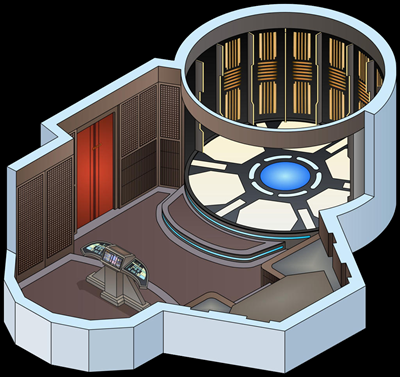 Aboard Century Class vessels Transporter Rooms are used to move lifeforms and small, inanimate objects to and from the ship. Located throughout the Enterprise, Transporter Rooms feature all key components needed for transport with additional support equipment located nearby.
Aboard Century Class vessels Transporter Rooms are used to move lifeforms and small, inanimate objects to and from the ship. Located throughout the Enterprise, Transporter Rooms feature all key components needed for transport with additional support equipment located nearby.Overseen by a Transporter Specialist, each Transporter Room includes a transporter chamber with a transporter platform. The transporter platform is fitted with six emitter pads, which were numbered clockwise beginning with the right front, that were used by the person being transported. A large section in the middle of the transporter platform could be used to transport large cargo to and from the ship.
Opposite the transporter chamber, the Transporter Specialist worked from a large display console located on an elevated platform. A large monitoring console, attached to the bulkhead behind the technician, provided an overview of the status of the transporter system. During more complicated transports a second technician could work in conjunction with the specialist from this wall console, such as if an emergency occurred where someone needed directly transported to sickbay or evacuation was required.
Entry to the Transporter Room was provided by a single door, which led to a staging area where an away team could prepare for their assignment. Opposite the entry, a storage locker held equipment and supplies an away team could check out for their assignment. A circuitry bay adjacent to the storage compartment maintained the pattern buffer and transporter computer system.
Transporter Room (Secondary)
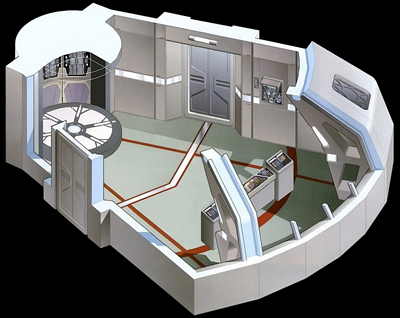 Compact and functional in design, Secondary Transporter Rooms are similar in capability to their primary counterparts elsewhere on the ship, but with some limitations. Due to their compact nature, the transporter pads in these rooms were smaller than those of the Primary Transporter Rooms on other decks and could not accommodate as many people at one time. Despite this, these transporter pads were fast and efficient in their responsibilities, easily transporting users to and from the ship.
Compact and functional in design, Secondary Transporter Rooms are similar in capability to their primary counterparts elsewhere on the ship, but with some limitations. Due to their compact nature, the transporter pads in these rooms were smaller than those of the Primary Transporter Rooms on other decks and could not accommodate as many people at one time. Despite this, these transporter pads were fast and efficient in their responsibilities, easily transporting users to and from the ship. The control console in Secondary Transporter Rooms is designed to be operated by two personnel. The technician on the left side of the panel controls the transporter sequence itself, operating the system and transporting visitors to and from the vessel. The technician on the right side of the panel monitors medical and security functions, screening arrivals through sensor reports for health issues or security threats. Blast shield covered windows are located in the bulkhead behind the operator and a nearby cabinet stores equipment for away teams.
Turbolift
 The Turbolift is a rapid transport unit aboard the Starship Enterprise. Capable of traveling both vertically and horizontally through a system of turboshafts between key sections of the ship, Turbolift allow for quick and efficient travel through the ship. Two Turbolift types are available aboard the Enterprise. Standard Turbolifts are general use lifts that can go to any Deck aboard the vessel while Express Turbolifts are only designed to go to specific locations aboard the starship.
The Turbolift is a rapid transport unit aboard the Starship Enterprise. Capable of traveling both vertically and horizontally through a system of turboshafts between key sections of the ship, Turbolift allow for quick and efficient travel through the ship. Two Turbolift types are available aboard the Enterprise. Standard Turbolifts are general use lifts that can go to any Deck aboard the vessel while Express Turbolifts are only designed to go to specific locations aboard the starship. Cylindrical in shape, the Turbolifts aboard the Enterprise are smaller than their predecessors yet can still comfortably transport crew and visitors throughout the ship. Aboard the Enterprise, the Turbolift operates by voice command operation, allowing passengers to use voice commands to direct the Turbolift to a destination. Upon receipt of the voice command, the destination queried the network allowing for the ships computers to determine the optimal route to the destination - incorporation the presence of other Turbolifts already in operation into the calculation. The auditory receivers also automatically scanned for voiceprint authentication, allowing access to restricted areas for authorized personnel.
Once in motion the Turbolift provided safe and quick travel, with motion dampening systems preventing most personnel from identifying that the lift is in operation. Light from the turboshaft frequently shone through the grid, serving as one of the few methods of identifying travel. A display on the back wall of the lift provided details on travel through the ship and allowed for the manual entry of a destination and further featured a built-in companel to allow communication with other sections of the ship without the need for a communicator.
Disclaimer
Categories: No categories found